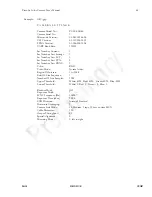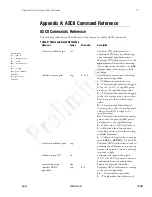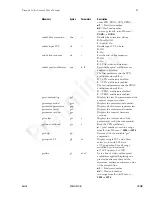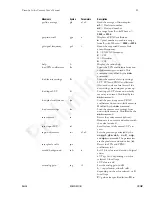
Piranha Color Camera User’s Manual
70
DALSA
03-032-10211-01
5/9/2007
4.2 Optical Interface
Illumination
The amount and wavelengths of light required to capture useful images depend on the
particular application. Factors include the nature, speed, and spectral characteristics of
objects being imaged, exposure times, light source characteristics, environmental and
acquisition system specifics, and more. DALSA’s Web site, http://vfm.dalsa.com/,
provides an introduction to this potentially complicated issue. See “Radiometry and
Photo Responsivity” and "Sensitivities in Photometric Units" in the CCD Technology
Primer found under the Application Support link.
It is often more important to consider exposure than illumination. The total amount of
energy (which is related to the total number of photons reaching the sensor) is more
important than the rate at which it arrives. For example, 5
μ
J/cm
2
can be achieved by
exposing 5mW/cm
2
for 1ms just the same as exposing an intensity of 5W/cm
2
for 1
μ
s.
Light Sources
Keep these guidelines in mind when setting up your light source:
LED light sources are relatively inexpensive, provide a uniform field, and longer life
span compared to other light sources. However, they also require a camera with
excellent sensitivity.
Halogen light sources generally provide very little blue relative to infrared light (IR).
Fiber-optic light distribution systems generally transmit very little blue relative to IR.
Some light sources age; over their life span they produce less light. This aging may not
be uniform—a light source may produce progressively less light in some areas of the
spectrum but not others.
Filters
CCD cameras are extremely responsive to infrared (IR) wavelengths of light. To prevent
infrared from distorting the images you scan, use a “hot mirror” or IR cutoff filter that
transmits visible wavelengths but does not transmit wavelengths over 750nm. Examples
are the Schneider Optics™ B+W 489, which includes a mounting ring, the CORION™
LS-750, which does not include a mounting ring, and the CORION™ HR-750 series
hot mirror.
Lens Modeling
Any lens surrounded by air can be modeled for camera purposes using three primary
points: the first and second principal points and the second focal point. The primary
points for a lens should be available from the lens data sheet or from the lens
manufacturer. Primed quantities denote characteristics of the image side of the lens.
That is,
h
is the object height and
h
′
is the image height.
The
focal point
is the point at which the image of an infinitely distant object is brought to
focus. The
effective focal length (f
′
)
is the distance from the second principal point to the
second focal point. The
back focal length (BFL)
is the distance from the image side of the
lens surface to the second focal point. The
object distance (OD)
is the distance from the
first principal point to the object.
Summary of Contents for PC-30-02K60
Page 6: ...Piranha Color Camera User s Manual 6 DALSA 03 032 10211 01 5 9 2007 ...
Page 32: ...Piranha Color Camera User s Manual 32 DALSA 03 032 10211 01 5 9 2007 Exposure Modes in Detail ...
Page 72: ...Piranha Color Camera User s Manual 72 DALSA 03 032 10211 01 5 9 2007 ...
Page 88: ...Piranha Color Camera User s Manual 88 DALSA 03 032 10211 01 5 9 2007 ...
Page 90: ...Piranha Color Camera User s Manual 90 DALSA 03 032 10211 01 5 9 2007 ...
Page 92: ...Piranha Color Camera User s Manual 92 DALSA 03 032 10211 01 5 9 2007 ...
Page 94: ...Piranha Color Camera User s Manual 94 DALSA 03 032 10211 01 5 9 2007 ...














































